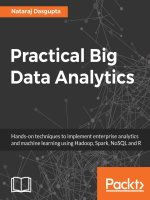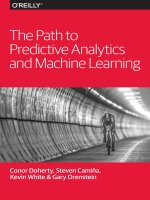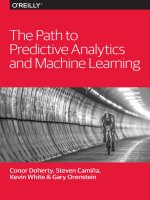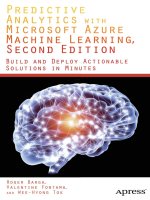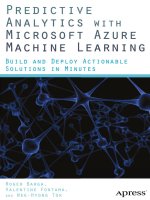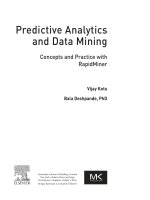IT training path to predictive analytics and machine learning khotailieu
Bạn đang xem bản rút gọn của tài liệu. Xem và tải ngay bản đầy đủ của tài liệu tại đây (4.23 MB, 89 trang )
Co
m
pl
im
en
ts
of
The Path to
Predictive Analytics
and Machine Learning
Conor Doherty, Steven Camiña,
Kevin White & Gary Orenstein
The Path to Predictive
Analytics and
Machine Learning
Conor Doherty, Steven Camiña,
Kevin White, and Gary Orenstein
Beijing
Boston Farnham Sebastopol
Tokyo
The Path to Predictive Analytics and Machine Learning
by Conor Doherty, Steven Camiña, Kevin White, and Gary Orenstein
Copyright © 2016 O’Reilly Media Inc. All rights reserved.
Printed in the United States of America.
Published by O’Reilly Media, Inc., 1005 Gravenstein Highway North, Sebastopol, CA
95472.
O’Reilly books may be purchased for educational, business, or sales promotional use.
Online editions are also available for most titles (). For
more information, contact our corporate/institutional sales department:
800-998-9938 or
Editors: Tim McGovern and
Debbie Hardin
Production Editor: Colleen Lobner
Copyeditor: Octal Publishing, Inc.
September 2016:
Interior Designer: David Futato
Cover Designer: Randy Comer
Illustrator: Rebecca Demarest
First Edition
Revision History for the First Edition
2016-08-25:
First Release
The O’Reilly logo is a registered trademark of O’Reilly Media, Inc. The Path to Pre‐
dictive Analytics and Machine Learning, the cover image, and related trade dress are
trademarks of O’Reilly Media, Inc.
While the publisher and the authors have used good faith efforts to ensure that the
information and instructions contained in this work are accurate, the publisher and
the authors disclaim all responsibility for errors or omissions, including without
limitation responsibility for damages resulting from the use of or reliance on this
work. Use of the information and instructions contained in this work is at your own
risk. If any code samples or other technology this work contains or describes is sub‐
ject to open source licenses or the intellectual property rights of others, it is your
responsibility to ensure that your use thereof complies with such licenses and/or
rights.
978-1-491-96966-3
[LSI]
Table of Contents
Introduction. . . . . . . . . . . . . . . . . . . . . . . . . . . . . . . . . . . . . . . . . . . . . . . . . . vii
1. Building Real-Time Data Pipelines. . . . . . . . . . . . . . . . . . . . . . . . . . . . . 1
Modern Technologies for Going Real-Time
2
2. Processing Transactions and Analytics in a Single Database. . . . . . . . 7
Hybrid Data Processing Requirements
Benefits of a Hybrid Data System
Data Persistence and Availability
8
9
10
3. Dawn of the Real-Time Dashboard. . . . . . . . . . . . . . . . . . . . . . . . . . . . 15
Choosing a BI Dashboard
Real-Time Dashboard Examples
Building Custom Real-Time Dashboards
17
18
20
4. Redeploying Batch Models in Real Time. . . . . . . . . . . . . . . . . . . . . . . 23
Batch Approaches to Machine Learning
Moving to Real Time: A Race Against Time
Manufacturing Example
Original Batch Approach
Real-Time Approach
Technical Integration and Real-Time Scoring
Immediate Benefits from Batch to Real-Time Learning
23
25
25
26
27
27
28
5. Applied Introduction to Machine Learning. . . . . . . . . . . . . . . . . . . . . 29
Supervised Learning
Unsupervised Learning
30
35
v
6. Real-Time Machine Learning Applications. . . . . . . . . . . . . . . . . . . . . . 39
Real-Time Applications of Supervised Learning
Unsupervised Learning
39
42
7. Preparing Data Pipelines for Predictive Analytics and
Machine Learning. . . . . . . . . . . . . . . . . . . . . . . . . . . . . . . . . . . . . . . . . . 45
Real-Time Feature Extraction
Minimizing Data Movement
Dimensionality Reduction
46
47
48
8. Predictive Analytics in Use. . . . . . . . . . . . . . . . . . . . . . . . . . . . . . . . . . . 51
Renewable Energy and Industrial IoT
PowerStream: A Showcase Application of Predictive
Analytics for Renewable Energy and IIoT
SQL Pushdown Details
PowerStream at the Command Line
51
52
58
58
9. Techniques for Predictive Analytics in Production. . . . . . . . . . . . . . . 63
Real-Time Event Processing
Real-Time Data Transformations
Real-Time Decision Making
63
67
68
10. From Machine Learning to Artificial Intelligence. . . . . . . . . . . . . . . . 71
Statistics at the Start
The “Sample Data” Explosion
An Iterative Machine Process
Digging into Deep Learning
The Move to Artificial Intelligence
71
72
72
73
76
A. Appendix. . . . . . . . . . . . . . . . . . . . . . . . . . . . . . . . . . . . . . . . . . . . . . . . . . 79
vi
|
Table of Contents
Introduction
An Anthropological Perspective
If you believe that as a species, communication advanced our evolu‐
tion and position, let us take a quick look from cave paintings,
to scrolls, to the printing press, to the modern day data storage
industry.
Marked by the invention of disk drives in the 1950s, data storage
advanced information sharing broadly. We could now record, copy,
and share bits of information digitally. From there emerged superior
CPUs, more powerful networks, the Internet, and a dizzying array of
connected devices.
Today, every piece of digital technology is constantly sharing, pro‐
cessing, analyzing, discovering, and propagating an endless stream
of zeros and ones. This web of devices tells us more about ourselves
and each other than ever before.
Of course, to meet these information sharing developments, we
need tools across the board to help. Faster devices, faster networks,
faster central processing, and software to help us discover and har‐
ness new opportunities.
Often, it will be fine to wait an hour, a day, even sometimes a week,
for the information that enriches our digital lives. But more fre‐
quently, it’s becoming imperative to operate in the now.
In late 2014, we saw emerging interest and adoption of multiple inmemory, distributed architectures to build real-time data pipelines.
In particular, the adoption of a message queue like Kafka, transfor‐
mation engines like Spark, and persistent databases like MemSQL
vii
opened up a new world of capabilities for fast business to under‐
stand real-time data and adapt instantly.
This pattern led us to document the trend of real-time analytics in
our first book, Building Real-Time Data Pipelines: Unifying Applica‐
tions and Analytics with In-Memory Architectures (O’Reilly, 2015).
There, we covered the emergence of in-memory architectures, the
playbook for building real-time pipelines, and best practices for
deployment.
Since then, the world’s fastest companies have pushed these archi‐
tectures even further with machine learning and predictive analyt‐
ics. In this book, we aim to share this next step of the real-time
analytics journey.
— Conor Doherty, Steven Camiña, Kevin White, and Gary Orenstein
viii
|
Introduction
CHAPTER 1
Building Real-Time Data Pipelines
Discussions of predictive analytics and machine learning often gloss
over the details of a difficult but crucial component of success in
business: implementation. The ability to use machine learning mod‐
els in production is what separates revenue generation and cost sav‐
ings from mere intellectual novelty. In addition to providing an
overview of the theoretical foundations of machine learning, this
book discusses pragmatic concerns related to building and deploy‐
ing scalable, production-ready machine learning applications. There
is a heavy focus on real-time uses cases including both operational
applications, for which a machine learning model is used to auto‐
mate a decision-making process, and interactive applications, for
which machine learning informs a decision made by a human.
Given the focus of this book on implementing and deploying
predictive analytics applications, it is important to establish context
around the technologies and architectures that will be used in pro‐
duction. In addition to the theoretical advantages and limitations of
particular techniques, business decision makers need an under‐
standing of the systems in which machine learning applications will
be deployed. The interactive tools used by data scientists to develop
models, including domain-specific languages like R, in general do
not suit low-latency production environments. Deploying models in
production forces businesses to consider factors like model training
latency, prediction (or “scoring”) latency, and whether particular
algorithms can be made to run in distributed data processing envi‐
ronments.
1
Before discussing particular machine learning techniques, the first
few chapters of this book will examine modern data processing
architectures and the leading technologies available for data process‐
ing, analysis, and visualization. These topics are discussed in greater
depth in a prior book (Building Real-Time Data Pipelines: Unifying
Applications and Analytics with In-Memory Architectures [O’Reilly,
2015]); however, the overview provided in the following chapters
offers sufficient background to understand the rest of the book.
Modern Technologies for Going Real-Time
To build real-time data pipelines, we need infrastructure and tech‐
nologies that accommodate ultrafast data capture and processing.
Real-time technologies share the following characteristics: 1) inmemory data storage for high-speed ingest, 2) distributed architec‐
ture for horizontal scalability, and 3) they are queryable for realtime, interactive data exploration. These characteristics are
illustrated in Figure 1-1.
Figure 1-1. Characteristics of real-time technologies
High-Throughput Messaging Systems
Many real-time data pipelines begin with capturing data at its source
and using a high-throughput messaging system to ensure that every
data point is recorded in its right place. Data can come from a wide
range of sources, including logging information, web events, sensor
data, financial market streams, and mobile applications. From there
it is written to file systems, object stores, and databases.
Apache Kafka is an example of a high-throughput, distributed mes‐
saging system and is widely used across many industries. According
to the Apache Kafka website, “Kafka is a distributed, partitioned,
replicated commit log service.” Kafka acts as a broker between pro‐
ducers (processes that publish their records to a topic) and consum‐
ers (processes that subscribe to one or more topics). Kafka can
handle terabytes of messages without performance impact. This
process is outlined in Figure 1-2.
2
|
Chapter 1: Building Real-Time Data Pipelines
Figure 1-2. Kafka producers and consumers
Because of its distributed characteristics, Kafka is built to scale pro‐
ducers and consumers with ease by simply adding servers to the
cluster. Kafka’s effective use of memory, combined with a commit
log on disk, provides ideal performance for real-time pipelines and
durability in the event of server failure.
With our message queue in place, we can move to the next piece of
data pipelines: the transformation tier.
Data Transformation
The data transformation tier takes raw data, processes it, and out‐
puts the data in a format more conducive to analysis. Transformers
serve a number of purposes including data enrichment, filtering,
and aggregation.
Apache Spark is often used for data transformation (see Figure 1-3).
Like Kafka, Spark is a distributed, memory-optimized system that is
ideal for real-time use cases. Spark also includes a streaming library
and a set of programming interfaces to make data processing and
transformation easier.
Modern Technologies for Going Real-Time | 3
Figure 1-3. Spark data processing framework
When building real-time data pipelines, Spark can be used to extract
data from Kafka, filter down to a smaller dataset, run enrichment
operations, augment data, and then push that refined dataset to a
persistent datastore. Spark does not include a storage engine, which
is where an operational database comes into play, and is our next
step (see Figure 1-4).
Figure 1-4. High-throughput connectivity between an in-memory
database and Spark
Persistent Datastore
To analyze both real-time and historical data, it must be maintained
beyond the streaming and transformations layers of our pipeline,
and into a permanent datastore. Although unstructured systems like
Hadoop Distributed File System (HDFS) or Amazon S3 can be used
for historical data persistence, neither offer the performance
required for real-time analytics.
On the other hand, a memory-optimized database can provide per‐
sistence for real-time and historical data as well as the ability to
query both in a single system. By combining transactions and ana‐
lytics in a memory-optimized system, data can be rapidly ingested
from our transformation tier and held in a datastore. This allows
4
|
Chapter 1: Building Real-Time Data Pipelines
applications to be built on top of an operational database that sup‐
plies the application with the most recent data available.
Moving from Data Silos to Real-Time Data Pipelines
In a world in which users expect tailored content, short load times,
and up-to-date information, building real-time applications at scale
on legacy data processing systems is not possible. This is because
traditional data architectures are siloed, using an Online Transac‐
tion Processing (OLTP)-optimized database for operational data
processing and a separate Online Analytical Processing (OLAP)optimized data warehouse for analytics.
The Enterprise Architecture Gap
In practice, OLTP and OLAP systems ingest data differently, and
transferring data from one to the other requires Extract, Transform,
and Load (ETL) functionality, as Figure 1-5 demonstrates.
Figure 1-5. Legacy data processing model
OLAP silo
OLAP-optimized data warehouses cannot handle one-off inserts
and updates. Instead, data must be organized and loaded all at once
—as a large batch—which results in an offline operation that runs
overnight or during off-hours. The tradeoff with this approach is
that streaming data cannot be queried by the analytical database
until a batch load runs. With such an architecture, standing up a
real-time application or enabling analyst to query your freshest
dataset cannot be achieved.
OLTP silo
On the other hand, an OLTP database typically can handle highthroughput transactions, but is not able to simultaneously run ana‐
lytical queries. This is especially true for OLTP databases that use
Modern Technologies for Going Real-Time | 5
disk as a primary storage medium, because they cannot handle
mixed OLTP/OLAP workloads at scale.
The fundamental flaw in a batch processing system can be illustra‐
ted through an example of any real-time application. For instance, if
we take a digital advertising application that combines user
attributes and click history to serve optimized display ads before a
web page loads, it’s easy to spot where the siloed model breaks. As
long as data remains siloed in two systems, it will not be able to
meet Service-Level Agreements (SLAs) required for any real-time
application.
Real-Time Pipelines and Converged Processing
Businesses implement real-time data pipelines in many ways, and
each pipeline can look different depending on the type of data,
workload, and processing architecture. However, all real-time pipe‐
lines follow these fundamental principles:
• Data must be processed and transformed on-the-fly so that it is
immediately available for querying when it reaches a persistent
datastore
• An operational datastore must be able to run analytics with low
latency
• The system of record must be converged with the system of
insight
One common example of a real-time pipeline configuration can be
found using the technologies mentioned in the previous section—
Kafka to Spark to a memory-optimized database. In this pipeline,
Kafka is our message broker, and functions as a central location for
Spark to read data streams. Spark acts as a transformation layer to
process and enrich data into microbatches. Our memory-optimized
database serves as a persistent datastore that ingests enriched data
streams from Spark. Because data flows from one end of this pipe‐
line to the other in under a second, an application or an analyst can
query data upon its arrival.
6
|
Chapter 1: Building Real-Time Data Pipelines
CHAPTER 2
Processing Transactions and
Analytics in a Single Database
Historically, businesses have separated operations from analytics
both conceptually and practically. Although every large company
likely employs one or more “operations analysts,” generally these
individuals produce reports and recommendations to be imple‐
mented by others, in future weeks and months, to optimize business
operations. For instance, an analyst at a shipping company might
detect trends correlating to departure time and total travel times.
The analyst might offer the recommendation that the business
should shift its delivery schedule forward by an hour to avoid traffic.
To borrow a term from computer science, this kind of analysis
occurs asynchronously relative to day-to-day operations. If the ana‐
lyst calls in sick one day before finishing her report, the trucks still
hit the road and the deliveries still happen at the normal time. What
happens in the warehouses and on the roads that day is not tied to
the outcome of any predictive model. It is not until someone reads
the analyst’s report and issues a company-wide memo that deliveries
are to start one hour earlier that the results of the analysis trickle
down to day-to-day operations.
Legacy data processing paradigms further entrench this separation
between operations and analytics. Historically, limitations in both
software and hardware necessitated the separation of transaction
processing (INSERTs, UPDATEs, and DELETEs) from analytical
data processing (queries that return some interpretable result
without changing the underlying data). As the rest of this chapter
7
will discuss, modern data processing frameworks take advantage of
distributed architectures and in-memory storage to enable the con‐
vergence of transactions and analytics.
To further motivate this discussion, envision a shipping network in
which the schedules and routes are determined programmatically
by using predictive models. The models might take weather and
traffic data and combine them with past shipping logs to predict the
time and route that will result in the most efficient delivery. In this
case, day-to-day operations are contingent on the results of analytic
predictive models. This kind of on-the-fly automated optimization
is not possible when transactions and analytics happen in separate
siloes.
Hybrid Data Processing Requirements
For a database management system to meet the requirements for
converged transactional and analytical processing, the following cri‐
teria must be met:
Memory optimized
Storing data in memory allows reads and writes to occur at realtime speeds, which is especially valuable for concurrent transac‐
tional and analytical workloads. In-memory operation is also
necessary for converged data processing because no purely diskbased system can deliver the input/output (I/O) required for
real-time operations.
Access to real-time and historical data
Converging OLTP and OLAP systems requires the ability to
compare real-time data to statistical models and aggregations of
historical data. To do so, our database must accommodate two
types of workloads: high-throughput operational transactions,
and fast analytical queries.
Compiled query execution plans
By eliminating disk I/O, queries execute so rapidly that dynamic
SQL interpretation can become a bottleneck. To tackle this,
some databases use a caching layer on top of their Relational
Database Management System (RDBMS). However, this leads
to cache invalidation issues that result in minimal, if any, perfor‐
mance benefit. Executing a query directly in memory is a better
8
|
Chapter 2: Processing Transactions and Analytics in a Single Database
approach because it maintains query performance (see
Figure 2-1).
Figure 2-1. Compiled query execution plans
Multiversion concurrency control
Reaching the high-throughput necessary for a hybrid, real-time
engine can be achieved through lock-free data structures and
multiversion concurrency control (MVCC). MVCC enables
data to be accessed simultaneously, avoiding locking on both
reads and writes.
Fault tolerance and ACID compliance
Fault tolerance and Atomicity, Consistency, Isolation, Durability
(ACID) compliance are prerequisites for any converged data
system because datastores cannot lose data. A database should
support redundancy in the cluster and cross-datacenter replica‐
tion for disaster recovery to ensure that data is never lost.
With each of the aforementioned technology requirements in place,
transactions and analytics can be consolidated into a single system
built for real-time performance. Moving to a hybrid database archi‐
tecture opens doors to untapped insights and new business opportu‐
nities.
Benefits of a Hybrid Data System
For data-centric organizations, a single engine to process transac‐
tions and analytics results in new sources of revenue and a simpli‐
fied computing structure that reduces costs and administrative
overhead.
Benefits of a Hybrid Data System | 9
New Sources of Revenue
Achieving true “real-time” analytics is very different from incremen‐
tally faster response times. Analytics that capture the value of data
before it reaches a specified time threshold—often a fraction of a
second—and can have a huge impact on top-line revenue.
An example of this can be illustrated in the financial services sector.
Financial investors and analyst must be able to respond to market
volatility in an instant. Any delay is money out of their pockets.
Limitations with OLTP to OLAP batch processing do not allow
financial organizations to respond to fluctuating market conditions
as they happen. A single database approach provides more value to
investors every second because they can respond to market swings
in an instant.
Reducing Administrative and Development Overhead
By converging transactions and analytics, data no longer needs to
move from an operational database to a siloed data warehouse to
deliver insights. This gives data analysts and administrators more
time to concentrate efforts on business strategy, as ETL often takes
hours to days.
When speaking of in-memory computing, questions of data persis‐
tence and high availability always arise. The upcoming section dives
into the details of in-memory, distributed, relational database sys‐
tems and how they can be designed to guarantee data durability and
high availability.
Data Persistence and Availability
By definition an operational database must have the ability to store
information durably with resistance to unexpected machine failures.
More specifically, an operational database must do the following:
• Save all of its information to disk storage for durability
• Ensure that the data is highly available by maintaining a readily
accessible second copy of all data, and automatically fail-over
without downtime in case of server crashes
These steps are illustrated in Figure 2-2.
10
|
Chapter 2: Processing Transactions and Analytics in a Single Database
Figure 2-2. In-memory database persistence and high availability
Data Durability
For data storage to be durable, it must survive any server failures.
After a failure, data should also be recoverable into a transactionally
consistent state without loss or corruption to data.
Any well-designed in-memory database will guarantee durability by
periodically flushing snapshots from the in-memory store into a
durable disk-based copy. Upon a server restart, an in-memory data‐
base should also maintain transaction logs and replay snapshot and
transaction logs.
This is illustrated through the following scenario:
Suppose that an application inserts a new record into a database.
The following events will occur as soon as a commit is issued:
1. The inserted record will be written to the datastore in-memory.
2. A log of the transaction will be stored in a transaction log buffer
in memory.
3. When the transaction log buffer is filled, its contents are flushed
to disk.
The size of the transaction log buffer is configurable, so if it is
set to 0, the transaction log will be flushed to disk after each
committed transaction.
4. Periodically, full snapshots of the database are taken and written
to disk.
Data Persistence and Availability | 11
The number of snapshots to keep on disk and the size of the
transaction log at which a snapshot is taken are configurable.
Reasonable defaults are typically set.
An ideal database engine will include numerous settings to control
data persistence, and will allow a user the flexibility to configure the
engine to support full persistence to disk or no durability at all.
Data Availability
For the most part, in a multimachine system, it’s acceptable for data
to be lost in one machine, as long as data is persisted elsewhere in
the system. Upon querying the data, it should still return a transac‐
tionally consistent result. This is where high availability enters the
equation. For data to be highly available, it must be queryable from a
system regardless of failures from some machines within a system.
This is better illustrated by using an example from a distributed sys‐
tem, in which any number of machines can fail. If failure occurs, the
following should happen:
1. The machine is marked as failed throughout the system.
2. A second copy of data in the failed machine, already existing in
another machine, is promoted to be the “master” copy of data.
3. The entire system fails over to the new “master” data copy,
removing any system reliance on data present in the failed sys‐
tem.
4. The system remains online (i.e., queryable) throughout the
machine failure and data failover times.
5. If the failed machine recovers, the machine is integrated back
into the system.
A distributed database system that guarantees high availability must
also have mechanisms for maintaining at least two copies of data at
all times. Distributed systems should also be robust, so that failures
of different components are mostly recoverable, and machines are
reintroduced efficiently and without loss of service. Finally, dis‐
tributed systems should facilitate cross-datacenter replication,
allowing for data replication across wide distances, often times to a
disaster recovery center offsite.
12
|
Chapter 2: Processing Transactions and Analytics in a Single Database
Data Backup
In addition to durability and high availability, an in-memory data‐
base system should also provide ways to create backups for the data‐
base. This is typically done by issuing a command to create on-disk
copies of the current state of the database. Such backups can also be
restored into both existing and new database instances in the future
for historical analysis and long-term storage.
Data Persistence and Availability | 13
CHAPTER 3
Dawn of the Real-Time Dashboard
Before delving further into the systems and techniques that power
predictive analytics applications, human consumption of analytics
merits further discussion. Although this book focuses largely on
applications using machine learning models to make decisions
autonomously, we cannot forget that it is ultimately humans design‐
ing, building, evaluating, and maintaining these applications. In fact,
the emergence of this type of application only increases the need
for trained data scientists capable of understanding, interpreting,
and communicating how and how well a predictive analytics appli‐
cation works.
Moreover, despite this book’s emphasis on operational applications,
more traditional human-centric, report-oriented analytics will not
go away. If anything, its value will only increase as data processing
technology improves, enabling faster and more sophisticated report‐
ing. Improvements like reduced Extract, Transform, and Load (ETL)
latency and faster query execution empowers data scientists and
increases the impact they can have in an organization.
Data visualization is arguably the single most powerful method for
enabling humans to understand and spot patterns in a dataset. No
one can look at a spreadsheet with thousands or millions of rows
and make sense of it. Even the results of a database query, meant to
summarize characteristics of the dataset through aggregation, can be
difficult to parse when it is just lines and lines of numbers. More‐
over, visualizations are often the best and sometimes only way to
communicate findings to a nontechnical audience.
15
Business Intelligence (BI) software enables analysts to pull data from
multiple sources, aggregate the data, and build custom visualizations
while writing little or no code. These tools come with templates that
allow analysts to create sophisticated, even interactive, visualization
without being expert frontend programmers. For example, an online
retail site deciding which geographical region to target its next ad
campaign could look at all user activity (e.g., browsing and purcha‐
ses) in a geographical map. This will help it to visually recognize
where user activity is coming from and make better decisions
regarding which region to target. An example of such a visualization
is shown in Figure 3-1.
Figure 3-1. Sample geographic visualization dashboard
Other related visualizations for an online retail site could be a bar
chart that shows the distribution of web activity throughout the dif‐
ferent hours of each day, or a pie chart that shows the categories of
products purchased on the site over a given time period.
Historically, out-of-the-box visual BI dashboards have been opti‐
mized for data warehouse technologies. Data warehouses typically
require complex ETL jobs that load data from real-time systems,
thus creating latency between when events happen and when infor‐
mation is available and actionable. As described in the last chapters,
technology has progressed—there are now modern databases
capable of ingesting large amounts of data and making that data
immediately actionable without the need for complex ETL jobs. Fur‐
16
|
Chapter 3: Dawn of the Real-Time Dashboard
thermore, visual dashboards exist in the market that accommodate
interoperability with real-time databases.
Choosing a BI Dashboard
Choosing a BI dashboard must be done carefully depending on
existing requirements in your enterprise. This section will not make
specific vendor recommendations, but it will cite several examples
of real-time dashboards.
For those who choose to go with an existing, third-party, out-of-thebox BI dashboard vendor, here are some things to keep in mind:
Real-time dashboards allow instantaneous queries to the underlying
data source
Dashboards that are designed to be real-time must be able to
query underlying sources in real-time, without needing to cache
any data. Historically, dashboards have been optimized for data
warehouse solutions, which take a long time to query. To get
around this limitation, several BI dashboards store or cache
information in the visual frontend as a performance optimiza‐
tion, thus sacrificing real-time in exchange for performance.
Real-time dashboards are easily and instantly shareable
Real-time dashboards facilitate real-time decision making,
which is enabled by how fast knowledge or insights from the
visual dashboard can be shared to a larger group to validate a
decision or gather consensus. Hence, real-time dashboards must
be easily and instantaneously shareable; ideally hosted on a
public website that allows key stakeholders to access the visuali‐
zation.
Real-time dashboards are easily customizable and intuitive
Customizable and intuitive dashboards are a basic requirement
for all good BI dashboards, and this condition is even more
important for real-time dashboards. The easier it is to build and
modify a visual dashboard, the faster it would be to take action
and make decisions.
Choosing a BI Dashboard | 17

